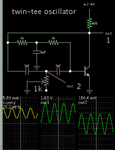nahlaelazab
Newbie level 5
Hi guys,
I want to design a sinusoidal VCO circuit around 25mhz depends on varying one of its resistors.
It is prefered to be CMOS based and contains no inductor.
I read that the opamp based oscillators are unsuitable due to their limiting frequency.
Can anyone recommend a circuit for me?
Thanks in advance
I want to design a sinusoidal VCO circuit around 25mhz depends on varying one of its resistors.
It is prefered to be CMOS based and contains no inductor.
I read that the opamp based oscillators are unsuitable due to their limiting frequency.
Can anyone recommend a circuit for me?
Thanks in advance
